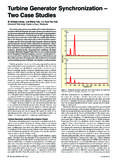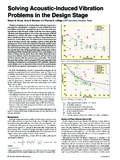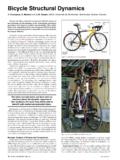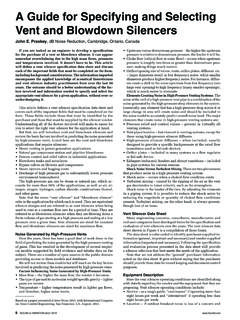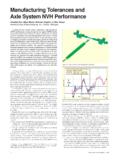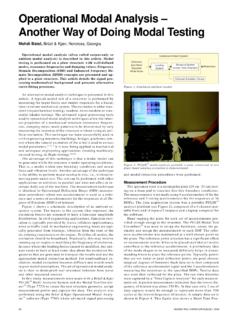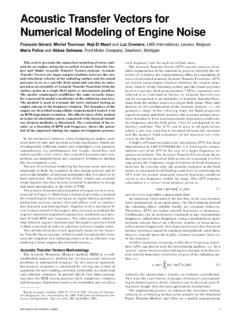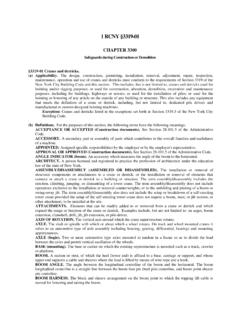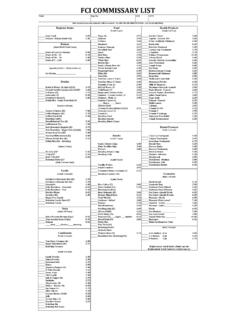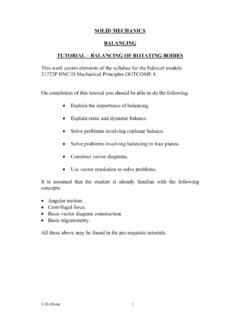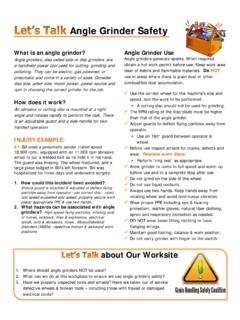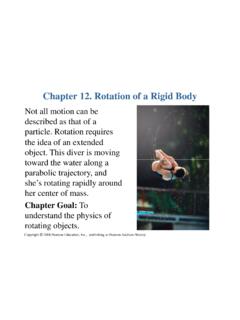Transcription of A Practical Review of Rotating Machinery Critical Speeds ...
1 10 SOUND AND VIBRATION/MAY 2005 The goal of this article is to present a Practical understand-ing of terminology and behavior based in visualizing how ashaft vibrates, and examining issues that affect vibration. Itis hoped that this presentation will help the nonspecialist bet-ter understand what is going on in the Machinery , and that thespecialist may gain a different view and/or some new the engineer unfamiliar with some of the unique char-acteristics of Rotating Machinery vibration, the terminology andbehavior of a machine can appear to be overwhelming. Likemost specialty areas, there are a number of excellent texts, butit can be difficult to quickly pull out the Practical insightneeded.
2 At the other end of the spectrum, there is also a largenumber of troubleshooting resources that focus on identifica-tion of problems and characteristics, but only offer limitedinsight. Discussion of a recent combined experimental andanalytical effort raised the possibility of an article that wouldattempt to provide a deeper insight into some of the basic char-acteristics of Rotating Machinery vibration from a less math-ematical , we have set out to discuss several issues that are ba-sic to an understanding of Rotating Machinery vibration:yWhat are Critical Speeds ?yHow do Critical Speeds relate to resonances and natural fre-quencies?
3 YHow do natural frequencies change as the shaft rotationalspeed changes?yHow are shaft rotational natural frequencies different frommore familiar natural frequencies and modes in structures?yWhat effects do bearing characteristics have?Vibration IntuitionAs a part of exploring the world as children, everyone is fa-miliar with the idea that banging on a structure will make itbounce back and vibrate. Some items vibrate more easily thanothers (a metal rod versus a wooden stick, for example). We alsohave intuition that it is easier to get things to vibrate or moveback and forth at certain frequenies.
4 For example, we tend tolearn that a swing with long ropes moves back and forth moreslowly than a swing with short ropes. Pumping the swing ata rate that matches the rate at which it wants to naturally moveback and forth will get you swinging much higher than ratesthat are faster or slower than the swing s natural of us have also had some experience with stringed in-struments. From this experience, we develop some idea thatheavy objects (thick strings) tend to vibrate at a lower frequencythan light objects (thin strings). We learn that increasing stiff-ness (tightening the string) raises the frequency of its , we also learn that decreasing a major dimension(shorter string) results in higher frequency Brief Review of Structural VibrationAs engineers, we learn that vibration characteristics are de-termined by a structure s mass and stiffness values, with damp-ing (ability to dissipate vibrational energy) playing an integralrole by controlling amplitudes.
5 This education generally startswith the simplest possible system a rigid mass attached to aspring as shown in Figure this simple system, we quantify our intuition aboutvibrational frequency (heavier objects result in lower fre-quency, stiffer springs yield higher frequency). After somework, we reach the conclusion that the free vibration frequencyis controlled by the square root of the ratio of stiffness to , we could (in principle) build a single degreeof freedom system consisting of a rigid block sitting on a we to push the block down and release it, we would findthat the displacement versus time is a sinusoidal function at asingle frequency, which is equal to the natural frequency as pre-dicted by Equation 1 and shown in Figure could then add a viscous damper parallel with the spring,and provide a sinusoidal force as shown in Figure 3.
6 By care-fully applying a constant amplitude sinusoidal force thatslowly increases in frequency and recording the amplitude ofthe motion, we could then generate the classic normalized fre-quency responses of a spring-mass-damper system. By repeat-ing the test with a variety of dampers, the classic frequencyresponse shown in Figure 4 can be developed. Assuming weknew the mass, stiffness and damping of our system, this re-sponse is also predicted quite well by the standard frequencydomain solution to the differential equation of motion for thissystem shown in Equation are several noteworthy points about these frequencyresponses.
7 The first is that at low excitation frequencies, theresponse amplitude is roughly constant and greater than amplitude is governed by the ratio of the applied force tothe spring stiffness. The second is that the response increasesto a peak, then rapidly decreases in the low and medium damp-ing peak frequency is approximately the damped naturalfrequency, (more technically correct, it is the peak responsefrequency, which moves down in frequency from the dampednatural frequency as damping increases). The system is said tobe in resonance when the excitation frequency matches thedamped natural frequency.
8 Very large amplitudes are possiblewhen the excitation frequency is close to this frequency. Theamplitude is controlled by the magnitude of the damping (moredamping reduces the amplitudes). The high damping case hasno real peak, and is said to be overdamped. Finally, the am-plitude continues to decrease for all higher frequencies. Thesecharacteristics will be contrasted with the response of a rotat-ing system to unbalance excitation in a later from the simple single mass system to multimasssystems, the basics do not change. Natural frequencies are stillprimarily related to mass and stiffness, with some changes dueto damping.
9 Excitation frequency equal to a damped naturalfrequency is a resonance. Excitation near a resonance can re-sult in large amplitude responses. Response amplitudes arecontrolled by damping. With enough damping, the responsepeak can be completely eliminated. The biggest change is thatthere are now multiple natural frequencies and that each natu-A Practical Review of RotatingMachinery Critical Speeds and ModesErik Swanson, Xdot-Consulting, Chapel Hill, North CarolinaChris D. Powell, Structural Technology Corporation, Zoar, OhioSorin Weissman, Alfa Wasserman, Inc., West Caldwell, New JerseyNatural Frequency = StiffnessMass(1)(2)AmplitudeFkmkck=- + 02221ww11 SOUND AND VIBRATION/MAY 2005ral frequency has a corresponding unique mode-shape withdifferent parts of the structure vibrating at different amplitudesand differing phases relative to one structures can be viewed as a series of finer and finerlumped mass approximations that approach a continuous massdistribution.
10 The continuous structure has an infinite numberof natural frequencies, each with its own characteristic vibra-tion shape (mode).As an example, consider a simple beam structure supportedby pin joints at each end. This structure is simple enough thata closed-form solution to the natural frequencies and modeshapes is possible. Equation 3 presents the resulting equationfor natural frequencies, and the first three mode shapes areshown in Figure essence, this equation is still just the square root of the ra-tio of stiffness to mass. The mode shapes shown in Figure 5and throughout the article are the shape of the beam at the po-sition of maximum displacement for a given (damped) naturalfrequency.

